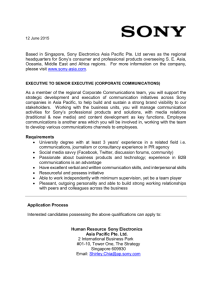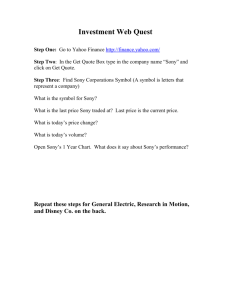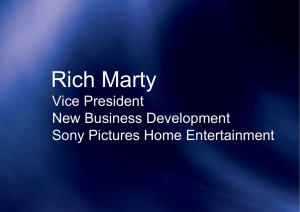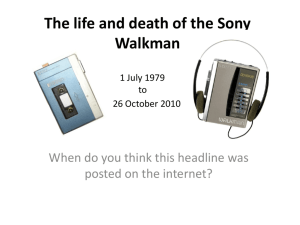Sony Corporation - SWOT analyses - UL2011-2012
advertisement
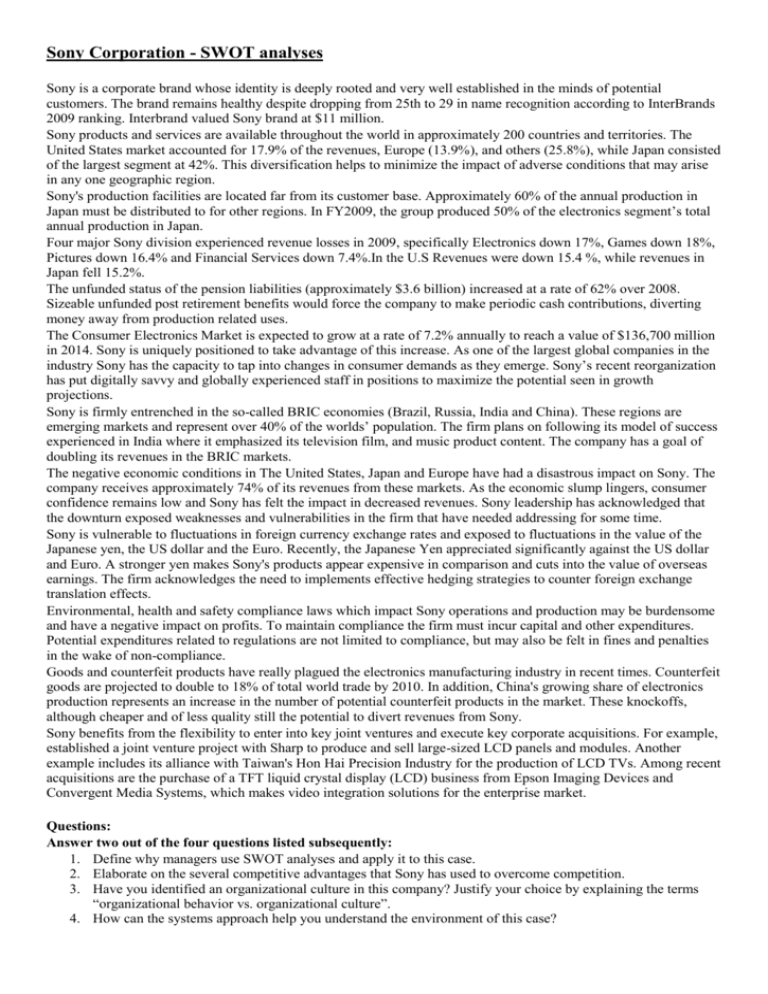
Sony Corporation - SWOT analyses Sony is a corporate brand whose identity is deeply rooted and very well established in the minds of potential customers. The brand remains healthy despite dropping from 25th to 29 in name recognition according to InterBrands 2009 ranking. Interbrand valued Sony brand at $11 million. Sony products and services are available throughout the world in approximately 200 countries and territories. The United States market accounted for 17.9% of the revenues, Europe (13.9%), and others (25.8%), while Japan consisted of the largest segment at 42%. This diversification helps to minimize the impact of adverse conditions that may arise in any one geographic region. Sony's production facilities are located far from its customer base. Approximately 60% of the annual production in Japan must be distributed to for other regions. In FY2009, the group produced 50% of the electronics segment’s total annual production in Japan. Four major Sony division experienced revenue losses in 2009, specifically Electronics down 17%, Games down 18%, Pictures down 16.4% and Financial Services down 7.4%.In the U.S Revenues were down 15.4 %, while revenues in Japan fell 15.2%. The unfunded status of the pension liabilities (approximately $3.6 billion) increased at a rate of 62% over 2008. Sizeable unfunded post retirement benefits would force the company to make periodic cash contributions, diverting money away from production related uses. The Consumer Electronics Market is expected to grow at a rate of 7.2% annually to reach a value of $136,700 million in 2014. Sony is uniquely positioned to take advantage of this increase. As one of the largest global companies in the industry Sony has the capacity to tap into changes in consumer demands as they emerge. Sony’s recent reorganization has put digitally savvy and globally experienced staff in positions to maximize the potential seen in growth projections. Sony is firmly entrenched in the so-called BRIC economies (Brazil, Russia, India and China). These regions are emerging markets and represent over 40% of the worlds’ population. The firm plans on following its model of success experienced in India where it emphasized its television film, and music product content. The company has a goal of doubling its revenues in the BRIC markets. The negative economic conditions in The United States, Japan and Europe have had a disastrous impact on Sony. The company receives approximately 74% of its revenues from these markets. As the economic slump lingers, consumer confidence remains low and Sony has felt the impact in decreased revenues. Sony leadership has acknowledged that the downturn exposed weaknesses and vulnerabilities in the firm that have needed addressing for some time. Sony is vulnerable to fluctuations in foreign currency exchange rates and exposed to fluctuations in the value of the Japanese yen, the US dollar and the Euro. Recently, the Japanese Yen appreciated significantly against the US dollar and Euro. A stronger yen makes Sony's products appear expensive in comparison and cuts into the value of overseas earnings. The firm acknowledges the need to implements effective hedging strategies to counter foreign exchange translation effects. Environmental, health and safety compliance laws which impact Sony operations and production may be burdensome and have a negative impact on profits. To maintain compliance the firm must incur capital and other expenditures. Potential expenditures related to regulations are not limited to compliance, but may also be felt in fines and penalties in the wake of non-compliance. Goods and counterfeit products have really plagued the electronics manufacturing industry in recent times. Counterfeit goods are projected to double to 18% of total world trade by 2010. In addition, China's growing share of electronics production represents an increase in the number of potential counterfeit products in the market. These knockoffs, although cheaper and of less quality still the potential to divert revenues from Sony. Sony benefits from the flexibility to enter into key joint ventures and execute key corporate acquisitions. For example, established a joint venture project with Sharp to produce and sell large-sized LCD panels and modules. Another example includes its alliance with Taiwan's Hon Hai Precision Industry for the production of LCD TVs. Among recent acquisitions are the purchase of a TFT liquid crystal display (LCD) business from Epson Imaging Devices and Convergent Media Systems, which makes video integration solutions for the enterprise market. Questions: Answer two out of the four questions listed subsequently: 1. Define why managers use SWOT analyses and apply it to this case. 2. Elaborate on the several competitive advantages that Sony has used to overcome competition. 3. Have you identified an organizational culture in this company? Justify your choice by explaining the terms “organizational behavior vs. organizational culture”. 4. How can the systems approach help you understand the environment of this case?
